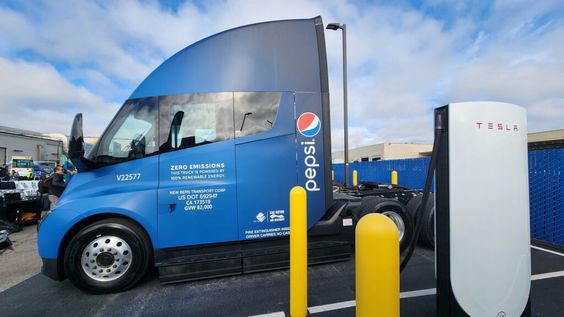One of the biggest beverage businesses in the world, PepsiCo, has taken a ground-breaking step toward sustainability. It has switched to a fleet of Tesla Semi Trucks at its Sacramento, California, production base. This success story in sustainable logistics is around the Tesla Semi Trucks, which have revolutionized the commercial sector.
PepsiCo has been a forerunner in embracing battery electric vehicles (BEVs) as a crucial component of its transportation strategy. The soda giant has aimed to eliminate emissions from its activities by 2040.
According to Amanda DeVoe, Director of Transformation and Strategy at Pepsi, adopting BEVs is firmly rooted in the company’s duty cycle. A sizable percentage of their business focuses on daily deliveries within 100 miles, operating vehicles for roughly 12 hours daily.
Tesla Semi’s Regenerative Braking in Action
Although Pepsi uses three Tesla Semi trucks specifically for long-haul routes covering distances of up to 450 miles, the majority of its Tesla Semi trucks are used for deliveries within a 100-mile radius. Dejan Antunović, Pepsi’s Electrification Program Manager, said:
“Going across Donnar’s Pass and back from [Sacramento] to Nevada, we’re able to, on the trip back, actually zero out, in terms of state of charge improving due to regenerative braking…It extends range for us in a way that is invaluable.”
The statement explains how the Tesla Semi’s regenerative braking technology is exceptionally beneficial during trips from Sacramento to Nevada, particularly when crossing Donner Pass. Regenerative braking is a feature that allows the electric vehicle to recover and store energy when the brakes are applied. As the Tesla Semi travels downhill and decelerates, the regenerative braking system captures the energy that would otherwise be lost as heat during traditional braking.
During the return trip from Nevada to Sacramento, the Tesla Semi benefits significantly from regenerative braking. The energy harvested from regenerative braking is used to recharge the vehicle’s batteries, effectively “zeroing out” the state of charge, meaning the truck gains back a considerable amount of previously used energy. This regenerative process extends the truck’s range, allowing it to cover more distance without requiring as many external charging sessions. On long-distance travel, the ability to regenerate energy while going downhill is seen as crucial because it increases the truck’s general efficiency and maximizes its range, making it the perfect choice for these strenuous treks.
Tesla Semi Trucks Charging Efficiency and Mega Charger Integration
Tesla has been building 750 kW Megachargers at PepsiCo sites to serve the charging requirements of its expanding electric fleet, allowing for quick charging of the Semi trucks. The Megachargers can charge the Tesla Semi to 80% of its capacity in approximately 45 minutes, minimizing truck downtime.

The Impressive Tesla Semi Trucks Energy Efficiency and Cost Savings
PepsiCo’s electrification program manager, Dejan Antunovic, shared that the Tesla Semi has achieved an average efficiency of 1.7 kWh per mile over the last few months, an impressive feat considering the off-peak electricity rates in Sacramento. This level of efficiency translates to a significant 23% fuel cost reduction compared to the most efficient diesel trucks, potentially leading to substantial savings for Pepsi’s large fleet of trucks over time.
Happy Tesla Semi Trucks Drivers and Future Plans
The video showcasing Pepsi’s use of Tesla Semi trucks also features several Tesla Semi truck drivers who express satisfaction with the electric trucks’ performance. Despite being used to traditional internal combustion engine (ICE) rigs, Pepsi’s staff has seamlessly adapted to the electric fleet, making the transition smooth and efficient.
PepsiCo’s partnership with Tesla and integration of the Tesla Semi into its fleet marks a significant step towards achieving sustainability goals and reducing carbon emissions. Pepsi’s northern California plant has been fully electrified and powered by solar energy, setting an inspiring example for the commercial industry. The success of Pepsi’s Tesla Semi adoption demonstrates a cleaner, more sustainable future for the logistics sector is not only possible but also a practical reality. As more companies follow suit, the revolution in trucking will accelerate, leading us to a greener and more eco-friendly world.









